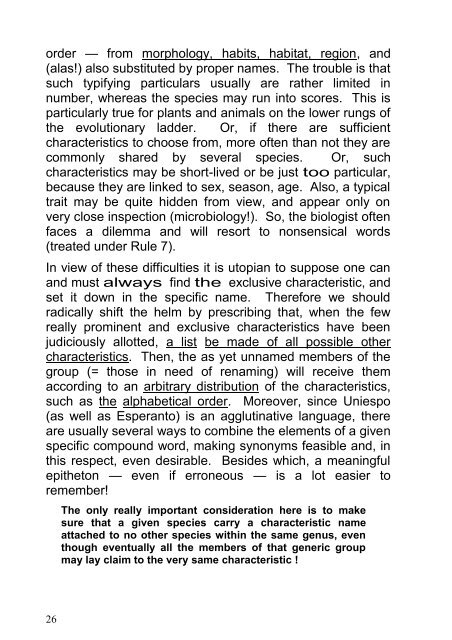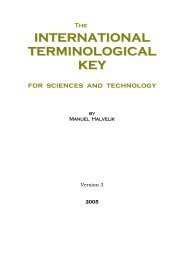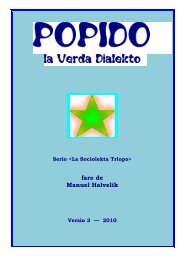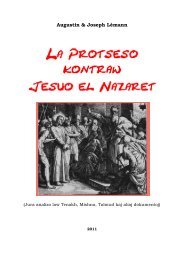the TRIMERAL SYSTEM in BIOLOGICAL TAXONOMY - universala ...
the TRIMERAL SYSTEM in BIOLOGICAL TAXONOMY - universala ...
the TRIMERAL SYSTEM in BIOLOGICAL TAXONOMY - universala ...
Create successful ePaper yourself
Turn your PDF publications into a flip-book with our unique Google optimized e-Paper software.
order — from morphology, habits, habitat, region, and<br />
(alas!) also substituted by proper names. The trouble is that<br />
such typify<strong>in</strong>g particulars usually are ra<strong>the</strong>r limited <strong>in</strong><br />
number, whereas <strong>the</strong> species may run <strong>in</strong>to scores. This is<br />
particularly true for plants and animals on <strong>the</strong> lower rungs of<br />
<strong>the</strong> evolutionary ladder. Or, if <strong>the</strong>re are sufficient<br />
characteristics to choose from, more often than not <strong>the</strong>y are<br />
commonly shared by several species. Or, such<br />
characteristics may be short-lived or be just too particular,<br />
because <strong>the</strong>y are l<strong>in</strong>ked to sex, season, age. Also, a typical<br />
trait may be quite hidden from view, and appear only on<br />
very close <strong>in</strong>spection (microbiology!). So, <strong>the</strong> biologist often<br />
faces a dilemma and will resort to nonsensical words<br />
(treated under Rule 7).<br />
In view of <strong>the</strong>se difficulties it is utopian to suppose one can<br />
and must always f<strong>in</strong>d <strong>the</strong> exclusive characteristic, and<br />
set it down <strong>in</strong> <strong>the</strong> specific name. Therefore we should<br />
radically shift <strong>the</strong> helm by prescrib<strong>in</strong>g that, when <strong>the</strong> few<br />
really prom<strong>in</strong>ent and exclusive characteristics have been<br />
judiciously allotted, a list be made of all possible o<strong>the</strong>r<br />
characteristics. Then, <strong>the</strong> as yet unnamed members of <strong>the</strong><br />
group (= those <strong>in</strong> need of renam<strong>in</strong>g) will receive <strong>the</strong>m<br />
accord<strong>in</strong>g to an arbitrary distribution of <strong>the</strong> characteristics,<br />
such as <strong>the</strong> alphabetical order. Moreover, s<strong>in</strong>ce Uniespo<br />
(as well as Esperanto) is an agglut<strong>in</strong>ative language, <strong>the</strong>re<br />
are usually several ways to comb<strong>in</strong>e <strong>the</strong> elements of a given<br />
specific compound word, mak<strong>in</strong>g synonyms feasible and, <strong>in</strong><br />
this respect, even desirable. Besides which, a mean<strong>in</strong>gful<br />
epi<strong>the</strong>ton — even if erroneous — is a lot easier to<br />
remember!<br />
26<br />
The only really important consideration here is to make<br />
sure that a given species carry a characteristic name<br />
attached to no o<strong>the</strong>r species with<strong>in</strong> <strong>the</strong> same genus, even<br />
though eventually all <strong>the</strong> members of that generic group<br />
may lay claim to <strong>the</strong> very same characteristic !






